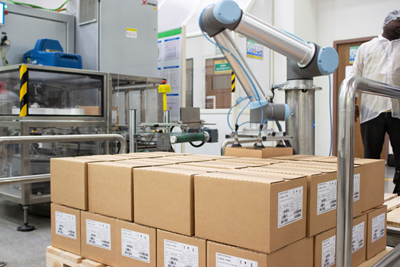Revolutionizing Warehousing: Collaborative Robots and Cost-Efficient Palletising
In the rapidly evolving landscape of manufacturing and logistics, automation has emerged as a game-changer, streamlining processes and boosting efficiency across various industries. One area that has witnessed significant transformation is palletising, a crucial step in warehousing and distribution centers. Traditional palletising methods are being revolutionized by the integration of collaborative robots, also known as cobots. These innovative machines are reshaping the way products are handled, stacked, and packed onto pallets, while simultaneously driving down costs and enhancing overall operational efficiency.
The Art of Palletising
Palletising, the process of arranging and stacking products onto pallets for storage or transportation, is a labor-intensive task that demands precision and consistency. Traditionally, this has been done manually, relying on human workers to repetitively lift, place, and stack items. However, this approach has its limitations. It’s time-consuming, prone to errors, and can lead to worker fatigue and injuries, all of which contribute to increased operational costs.
Enter Collaborative Robots
Collaborative robots, or cobots, are designed to work alongside humans in a shared workspace. Unlike traditional industrial robots, cobots are built with advanced sensors, safety features, and user-friendly interfaces that enable them to interact safely and intelligently with human operators. In the context of palletising, cobots offer a host of benefits that directly address the challenges associated with manual palletising.
Benefits of Cobots in Palletising
- Increased Efficiency: Cobots can work tirelessly without breaks, significantly reducing the time required for palletising. They can operate around the clock, accelerating the overall production process and ensuring timely order fulfillment.
- Consistent Precision: Human errors are inevitable, especially during repetitive tasks. Universal Robots, on the other hand, execute tasks with consistent accuracy, resulting in neatly stacked pallets and minimized product damage.
- Flexibility and Adaptability: Cobots are easily programmable to handle various product types, sizes, and packaging configurations. This flexibility makes them ideal for businesses that deal with diverse and large quantity inventories.
- Cost Savings: While the initial investment in cobots may seem significant, the long-term cost savings are substantial. Reduced labor costs, decreased product wastage due to improved handling, and minimized risk of workplace injuries contribute to a compelling return on investment (ROI).
- Safety First: Cobots are equipped with sensors and safety mechanisms that detect the presence of humans and obstacles, ensuring a safe working environment. This eliminates the risks associated with heavy lifting and repetitive strain injuries.
- Employee Empowerment: By automating mundane and physically demanding tasks, cobots free up human workers to focus on more strategic and creative aspects of their jobs, leading to increased job satisfaction and improved morale.
Integrating cobots into a palletising workflow involves several steps:
- Task Analysis: Identify the specific palletising tasks that can be automated using cobots. Consider factors such as payload, reach, and the complexity of the task.
- Cobot Selection: Choose a Universal Robot model that aligns with your requirements. Factors to consider include payload capacity, reach, programming capabilities, and safety features.
- Programming: Cobots can be programmed using intuitive interfaces that require minimal technical expertise. Programming may involve teaching the cobot the desired paths, motions, and stacking patterns.
- Testing and Optimization: Thoroughly test the cobot’s performance and optimize its movements to achieve maximum efficiency and accuracy.
- Collaborative Workspace Design: Ensure that the workspace is designed to accommodate both cobots and human workers safely and efficiently. Implement safety barriers, sensors, and visual cues to prevent collisions and accidents.
Collaborative robots are ushering in a new era of efficiency and cost-effectiveness in palletising and various other industrial processes. By leveraging their capabilities, businesses can transform their operations, reduce operational costs, enhance employee safety, and gain a competitive edge in today’s dynamic marketplace. As cobot technology continues to advance, the potential applications within logistics and manufacturing are virtually limitless, promising a future where human and machine collaboration optimizes productivity and innovation.
Contact us today to discuss what palletising solution is right for you – email sales@cobots.ie

